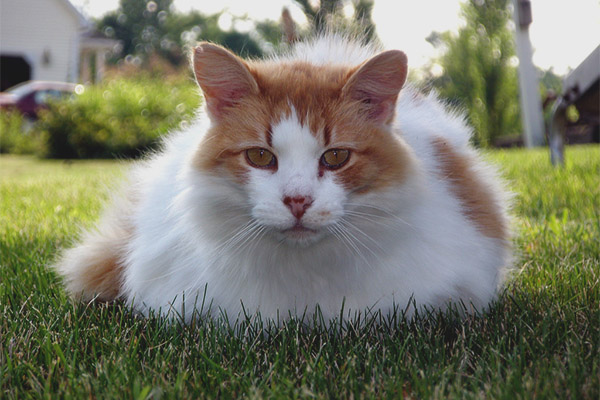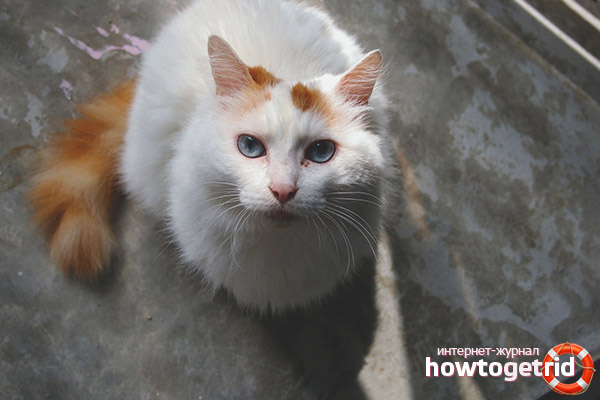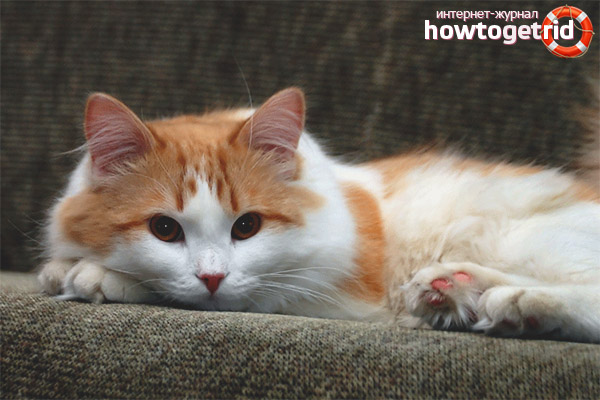The content of the article
This story began in the region of eastern Anatolia in Turkey. It was there that the first representatives of the cat breed appeared, which were later officially recognized as the Turkish van. For many centuries they lived near the shore of Lake Van, happily swimming in salt water and savoring small fish.
But that all changed when the journalist Laura Washington arrived from Britain. She not only made interesting reports and photos about Turkish life and residents, but also drew attention to amazing cats due to their unique color: snow-white fur and contrasting color on the head and tail. It was 1955. The woman was delighted, as the kittens are splashing and playing in the water, and she willingly accepted two kittens as a gift. After 4 years, the journalist returned to buy two more kittens.So European fans of cats learned that there is an opportunity to decorate the house with an original and friendly pet.
For the first time officially started talking about the breed in 1969, but at that time these cats were recognized as the “Turkish” breed.
The FIFE Association officially recognized the Turkish cat, defining its standards. This event is documented in 1971. However, to avoid confusion, since such a breed as the “Turkish Angora Cat” already existed, in 1979 the British, and in 1985 the Americans began to officially call the indigenous people who were accustomed to dwell at Lake Van, a Turkish van.
Distinctive features of the feline inhabitant of Turkey
Representatives of this breed are usually large in size:
- adults can weigh cats from 4 to 5.5 kg;
- cats - from 6 to 10 kg.
The length, measured from the nose to the tail inclusive, is from 85 to 120 cm. The height can be from 35 to 45 cm. The average standard of living of the Van is about 15 years.
Their standard description is as follows:
- Head size is medium or larger, but mostly in cats it is much larger. In addition, the head is elongated, resembles a wedge shape, but with a soft, rounded contour. Look the same rounded forehead and chin. The cheekbones are quite high. Muzzle very neat.Pinch is pronounced, but not so bright.
- The eyes are large, wide open. Set on a slope, visibly elongated in the corners. Many admirers of cats are attracted to the Turkish van with eye color — blue, yellow with an amber shade or with different colors of each eye.
- The nose should be pink. The same condition, according to the standard, remains on the paw pads.
- Ears set high, wide apart. At the base they are wide. There are features here - the inner edge is slightly turned to the outer side, while the outer one is located straight.
- The neck is strong, with pronounced musculature, short. The shoulders are wide.
- The body is large and long, well developed physically, cats are especially distinguished by this. The chest is full and round. It is noticeable that towards the pelvis, which is also highly developed, the body begins to gradually narrow. Cats look neat due to the fact that the body has neither too flat lines nor angularities.
- The paws are of medium length, the hind ones are not much, but still longer. The pads contain soft brushes located between the fingers.
- The tail is associated with a brush or a train. It is quite proportional, of medium length.
- Wool up to 5 cm long is considered a half-length. It is very reminiscent of cashmere, and its unique properties are that the villi are waterproof, so the pet quickly becomes dry after bathing. No undercoat. Due to the peculiarities of the natural climate, it turned out that the Van cat in the summer season has shorter hair, and in order to protect it from the scorching sun, the villi become much tougher. But there is a long coat on the abdomen and in the area of "pants". When the cold comes, the hair becomes thicker and longer throughout the body, the head does not affect the abundance of wool. Fluffy collar and tail should be required.
Color
The color can vary very widely: the obligatory presence of white is combined with black or red, blue or cream, etc. There is even a special term - “turtle-white Van color”. The main distinctive features must be present - these are colored markings resembling a pattern and located on a white background.
Standard conditions allow for the markings and the very tip of the tail to have small white blotches.Part of the color should cover small areas - the head and tail - only 20 percent of the entire wool.
If the pet has a color like tabby, there is a rule: the tail must necessarily have stripes that look much brighter from above. Some cats may have a small color speck on their left shoulder. On this occasion, there is a belief that the devil did not like it, that Noah and his family and the animals survived, so he sent his cunning envoy, an inconspicuous mouse, to the ship, so that she would gnaw holes in the ark, and everyone would die. But Allah protected them, blessing the Turkish Van to fight the enemy. In order for the cat-protector to win, Allah left a special mark on his shoulder.
The standard rules state that a completely white color is acceptable, but in this case there should be no additional patterns or color markings. This type of color is called experts "van Cedisi".
The unspoken leader of the apartment
Having settled in the house as a pet, a Turkish van very quickly gets used to the new conditions and its owners. In time, his favorite occupation is to get to a high place, for example, a cupboard, and from there watch with interest everything that happens in the house.Climbing somewhere for a van is not at all problematic, because his paws are strong and strong, even at a very young age.
Kittens are very energetic, almost always vigorous and active, which is preserved in them at a respectable age. Play with them is always fun and interesting. Turkish vans are able to raise the mood of the owners, grabbing any items on the fly, can comfortably tumble and compete in the race. They can also skillfully repeat all these stunts in the water at the same professional level.
These animals are able to skillfully organize hunting, because another pet, a smaller one, may suffer from the predatory habits of the Van. But even larger pets can also feel the cat's abrupt temper due to the fact that the Turkish representative must always prove his superiority, fighting with all his might for the attention of his hosts. Having proved his leadership, the cat will get along well with other animals. This breed gives in to training relatively easily, quickly taught to execute commands.
But not only physical activity makes the fans of cats when choosing to stop on this breed. These animals are very smart, and if the owner is depressed, they can sit on their knees or close by,but more often it is more convenient for them to climb up to the neck, and to begin a heart-to-heart purring conversation, changing constantly the tonality. They like to accompany the owners around the house and on the street. To the Turkish van is not lost in the city courtyards, from an early age it is necessary to accustom him to the leash. This process usually does not cause animal discontent. However, violating their personal space, even the owners can get a decent rebuff.
A special joy in a pet is a trip to the pond. Here the cat splashes from the heart, makes somersaults and can even catch a small fish.
Diseases and nutrition
Turkish vans have excellent health. But some diseases are still susceptible. First of all, hypertrophic cardiomyopathy is dangerous. This disease is caused by pathologies occurring in the heart. It is believed that the disease in animals is inherited.
The state of health of the pet must be monitored constantly. Since this breed is notable for its cheerful disposition and great activity, in the case when the animal has become lethargic and sad, it does not rise from its place, you should definitely show it to the vet.
To save the Turkish bath excellent health, you need a balanced diet. The diet should contain foods with an increased amount of proteins and carbohydrates. Dry cat food is eaten with pleasure, but when choosing it, it is better to give preference to the premium class - this is where the main nutrients are collected. Choosing food for small Vans, it is advisable to buy those which are indicated that they are intended for active animals.
Be sure to need a fresh fish. And remember that the wrong diet or overeating can cause allergic reactions.
Specific care
- Due to the fact that the undercoat of the Turkish Van is absent, grooming is greatly simplified and it is necessary to comb them once every 7 days. But when the molting period comes, the task becomes more complicated. In this short time, you need to pay attention to the wool 3-4 times a week in order to remove fallen hair as quickly as possible.
- Frequent bathing is not recommended because the wool has the ability to self-clean. But, if the pet wanted to bathe on its own, nothing would stop it, therefore it is advisable to keep the toilet lid in the house closed. During water procedures, the owner should give the opportunity to bathe in plenty.
- Ears should be treated as dirty, and teeth should be brushed periodically.
- To keep the white coat clean and fresh, you need to clean the tray all the time.
A cat from the shore of Van requires vaccinations!
In order to avoid dangerous diseases that are detrimental to a cat's pet, a first vaccination is made already after 12 weeks of age. What kind of vaccine is needed - the vet will tell you, but in the future you need to use the same drug, without going beyond the terms appointed by the vet. It is necessary to de-worming before each vaccination.
The difficulty of acquisition
Therefore, if there is a proposal that there is an opportunity to buy a purebred bath, you need to check the documents and passport, be sure to compare the standard conditions of the breed.Only by making sure that the kitten meets the standards, and you need to take into account the physical development, you can make a purchase. And there is a real van from 30 thousand rubles. up to several thousand euros.
For mating, it is desirable to choose a decent pair in order to successfully continue the genus of this beautiful breed, which began its existence at the far away Lake Van. Before this, it is desirable to clear the body of pet worms.
Video: cat breed Turkish van













To send